
A covered bridge is a timber-truss bridge with a roof, decking, and siding, which in most covered bridges create an almost complete enclosure. The purpose of the covering is to protect the wooden structural members from the weather. Uncovered wooden bridges typically have a lifespan of only 20 years because of the effects of rain and sun, but a covered bridge could last over 100 years. In the United States, only about 1 in 10 survived the 20th century. The relatively small number of surviving bridges is due to deliberate replacement, neglect, and the high cost of restoration.

The 1940 Tacoma Narrows Bridge, the first bridge at this location, was a suspension bridge in the U.S. state of Washington that spanned the Tacoma Narrows strait of Puget Sound between Tacoma and the Kitsap Peninsula. It opened to traffic on July 1, 1940, and dramatically collapsed into Puget Sound on November 7 of the same year. The bridge's collapse has been described as "spectacular" and in subsequent decades "has attracted the attention of engineers, physicists, and mathematicians". Throughout its short existence, it was the world's third-longest suspension bridge by main span, behind the Golden Gate Bridge and the George Washington Bridge.

A truss is an assembly of members such as beams, connected by nodes, that creates a rigid structure.
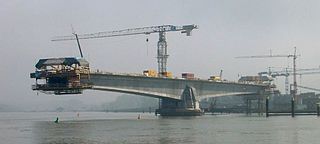
A cantilever bridge is a bridge built using structures that project horizontally into space, supported on only one end. For small footbridges, the cantilevers may be simple beams; however, large cantilever bridges designed to handle road or rail traffic use trusses built from structural steel, or box girders built from prestressed concrete.

A truss bridge is a bridge whose load-bearing superstructure is composed of a truss, a structure of connected elements, usually forming triangular units. The connected elements, typically straight, may be stressed from tension, compression, or sometimes both in response to dynamic loads. There are several types of truss bridges, including some with simple designs that were among the first bridges designed in the 19th and early 20th centuries. A truss bridge is economical to construct primarily because it uses materials efficiently.

Lavr Dmitrievich Proskouriakov was one of the foremost authorities on bridge engineering and structural mechanics in the Russian empire and the early Soviet Union.

The Sciotoville Bridge is a steel continuous truss bridge carrying CSX Transportation railroad tracks across the Ohio River between Siloam - a junction located north of Limeville, Kentucky and east of South Shore, Kentucky - and Sciotoville, Ohio in the United States. Designed by Gustav Lindenthal, the bridge was constructed in 1916 by Chesapeake and Ohio Railway subsidiary Chesapeake and Ohio Northern Railway as part of a new route between Ashland, Kentucky and Columbus, Ohio.
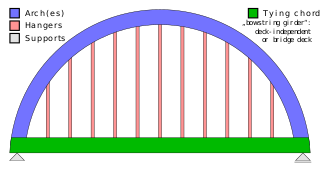
A tied-arch bridge is an arch bridge in which the outward-directed horizontal forces of the arch(es) are borne as tension by a chord tying the arch ends rather than by the ground or the bridge foundations. This strengthened chord may be the deck structure itself or consist of separate, independent tie-rods.

A continuous truss bridge is a truss bridge that extends without hinges or joints across three or more supports. A continuous truss bridge may use less material than a series of simple trusses because a continuous truss distributes live loads across all the spans; in a series of simple trusses, each truss must be capable of supporting the entire load.
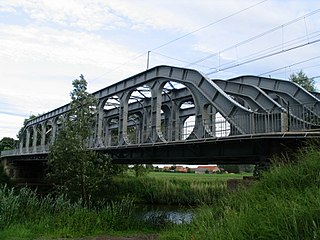
A Vierendeel bridge is a bridge employing a Vierendeel truss, named after Arthur Vierendeel.

The Hawkesbury River railway bridge is a heritage-listed railway bridge in New South Wales, Australia that carries the Main North railway line across the Hawkesbury River. The bridge crosses between Brooklyn on the northern outskirts of Sydney and Cogra Bay in the Central Coast region. The railway bridge was to be the last link in a railway network that linked the state capitals Adelaide, Melbourne, Sydney and Brisbane and was a major engineering feat at the time. The original railway bridge was built in 1889 and replaced by the current bridge in 1946. The 1946 bridge was added to the New South Wales State Heritage Register on 2 April 1999.

A Howe truss is a truss bridge consisting of chords, verticals, and diagonals whose vertical members are in tension and whose diagonal members are in compression. The Howe truss was invented by William Howe in 1840, and was widely used as a bridge in the mid to late 1800s.
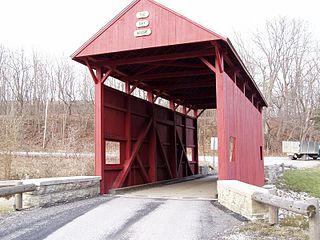
A queen post is a tension member in a truss that can span longer openings than a king post truss. A king post uses one central supporting post, whereas the queen post truss uses two. Even though it is a tension member, rather than a compression member, they are commonly still called a post. A queen post is often confused with a queen strut, one of two compression members in roof framing which do not form a truss in the engineering sense.
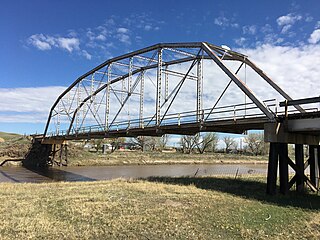
The EDZ Irigary Bridge is a historic Pennsylvania truss bridge in southeastern Johnson County, Wyoming. The bridge was built in 1913 at Sussex, Wyoming, and moved in 1963 to Irigary Road. The bridge was listed on the National Register of Historic Places in 1985 as part of a Multiple Property Submission devoted to historic bridges in Wyoming.

On May 23, 2013, at approximately 7:00 pm PDT, a span of the bridge carrying Interstate 5 over the Skagit River in the U.S. state of Washington collapsed. Three people in two different vehicles fell into the river below and were rescued by boat, escaping serious injury. The cause of the catastrophic failure was determined to be an oversize load striking several of the bridge's overhead support beams, leading to an immediate collapse of the northernmost span.

The Capon Lake Whipple Truss Bridge, formerly known as South Branch Bridge or Romney Bridge, is a historic Whipple truss bridge in Capon Lake, West Virginia. It is located off Carpers Pike and crosses the Cacapon River. The bridge formerly carried Capon Springs Road over the river, connecting Capon Springs and Capon Lake.
The Fink truss is a commonly used truss in residential homes and bridge architecture. It originated as a bridge truss although its current use in bridges is rare.

The Florida International University pedestrian bridge collapse occurred on March 15, 2018, when a 175-foot-long section of the FIU-Sweetwater UniversityCity Pedestrian Bridge collapsed while under construction. The collapse resulted in six deaths, ten injuries, and eight vehicles being crushed underneath. Of the serious injuries, one employee was permanently disabled. At the time of the collapse, six lanes of road beneath the bridge were open to traffic.

Emu Plains Underbridge is a heritage-listed steel truss railway underbridge located off Bruce Neale Dr approximately 1.3 kilometres (0.81 mi) west of the Penrith railway station in the western Sydney suburb of Penrith in the City of Penrith local government area of New South Wales, Australia. It was designed by James Fraser, the existing lines branch and the New South Wales Government Railways. It was built in 1907, with fabrication by R. Tulloch & Co.; and erection by day labour. It is also known as Emu Plains Underbridge and Penrith Underbridge. The property is owned by Transport Asset Holding Entity, an agency of the Government of New South Wales. It was added to the New South Wales State Heritage Register on 28 June 2013.


















